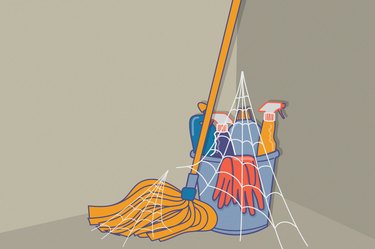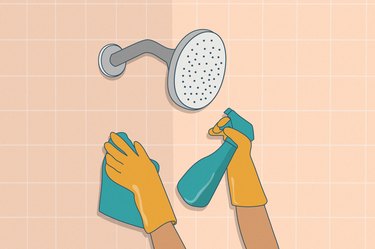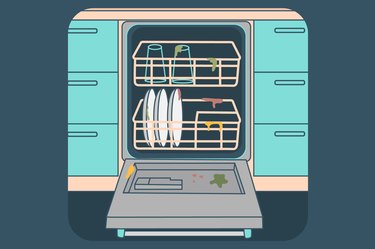
Mold in your home can stem from problems like leaks, flood, a humidifier that's running too high or even just not cleaning often enough. But there's one more culprit you might not have considered: clogged gutters.
Gutters are designed to divert rainwater away from your house by collecting it and sending it through your downspouts. The shallow troughs can overflow, though, if they become filled with leaves, dirt or debris. That can allow water to seep into your home and set the stage for mold, explains Michael Rubino, author of The Mold Medic and founder of the indoor air quality brand HomeCleanse.
Video of the Day
Video of the Day
"If there are weak points where the gutter meets the roof, when water is overflowing in the gutter, water can intrude into the house," Rubino says. Gutter overflow can also cause water to be dumped directly onto your home's foundation (instead of beyond the foundation), which can cause moisture to accumulate to in basements or crawlspaces, he adds.
And any time water or moisture begins to build up, you've got ideal conditions for mold. The fungus grows and spreads on damp, organic matter, including wet building materials like walls or insulation, according to The National Institute for Occupational Safety and Health (NIOSH). And it can happen quickly: "Mold colonies can form in as little as 24 to 48 hours," Rubino notes.
What Makes Mold So Bad?
Mold isn't just gross to look at. It can irritate your respiratory system and exacerbate existing lung problems.
Even those who aren't allergic to mold can develop a stuffy nose, wheezing or itchy eyes or skin from breathing the stuff in, according to the Centers for Disease Control and Prevention (CDC). (Eating it can make you sick too, but that's more of a concern for moldy food than moldy, uh, walls.)
Reactions can be more severe for people who do have mold allergies, asthma or chronic respiratory illnesses like emphysema or COPD: Think rashes (for people with mold allergies), chest tightness or even shortness of breath. Exposure to mold can also up the risk for upper respiratory infections and coughing, even in healthy people, according to the CDC. Those with compromised immune systems or underlying lung problems can also develop fungal infections.
In some cases, mold can also trigger the development of new health problems. Inhaling or touching mold spores can actually cause a person to become allergic to mold, per the CDC. Exposure to household mold may also be linked to an increased risk of childhood asthma, concluded a cross-sectional study of 40,000 U.S. kids published in the April 2021 issue of the International Journal of Hygiene and Environmental Health.
How to Clean Your Gutters to Prevent Mold
Keeping your gutters free of debris can keep water out of your home, which can reduce the risk for excess moisture buildup and mold growth. Here's exactly what you should do to keep them clean:
- Set a schedule. Start by checking your gutters every one to two months for debris buildup, Rubino recommends. You may be able to get away with doing it less often — maybe just a few times a year — if you have guards installed on your gutters. Check your manufacturer's recommendations to figure out the best timeline for you.
- Gather your supplies. You'll need a ladder, tarp and heavy-duty rubber gloves.
- Spread out the tarp. Before going up the ladder, line the area under your ladder with a tarp to catch whatever debris you toss out of the gutters for easy cleanup. Make sure you have a pair of rubber gloves on, too. Things are going to get messy.
- Remove gunk. If you see leaves, sticks, dirt or other debris building up in the gutters, pull the stuff out by hand or with a plastic gutter scoop ($3.35, Amazon.com) and toss it down onto the tarp, Rubino says.
- Hose it down. Once you've cleared the bulk of the clutter, use a garden hose to spray away any leftover bits that are small enough to flow through the downspout.
Tip
Since you'll need to climb a ladder to see into the gutters (and get rid of the gunk), consider calling in a pro if you have trouble balancing or aren't comfortable with heights.
Chances are you'll be cleaning your gutters on a dry day. But you should get into the habit, too, of taking a look at how the gutters are performing when it's actually raining. "If you see them overflowing and water is pouring over the side, you need to clean them quickly," Rubino says.
- National Institute for Occupational Safety and Health: What Is Mold?
- Centers for Disease Control and Prevention: "Basic Facts about Mold and Dampness"
- Centers for Disease Control and Prevention: "Health Problems Related to Dampness and Mold"
- International Journal of Hygiene and Environmental Health: "Household mold, pesticide use, and childhood asthma: A nationwide study in the U.S"
Was this article helpful?
150 Characters Max
0/150
Thank you for sharing!
Thank you for your feedback!
Is this an emergency? If you are experiencing serious medical symptoms, please see the National Library of Medicine’s list of signs you need emergency medical attention or call 911.


